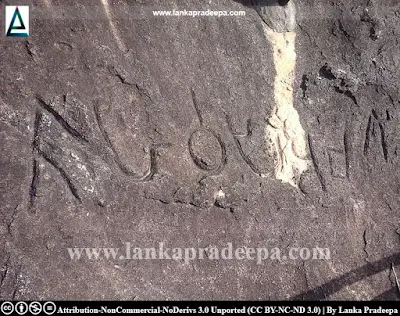
|
Thonigala Rock Inscription I |
Two pre-Christian inscriptions known as Thonigala Rock Inscriptions (Sinhala: තෝනිගල ශිලා ලේඛන) are found inscribed on a low rock called Thonigala situated near Paramakanda Raja Maha Viharaya in Anamaduwa in Puttalam District, Sri Lanka.
Inscriptions
There are two long and large rock inscriptions at the site. The letters of both inscriptions are about a foot long and have been cut an inch deep in the rock, forming triangular grooves (Muller, 1883; Parker, 1909). The two inscriptions are located on the same rock group about 100 m away from each other. Some parts of the second inscription have been destroyed by an attempt made to blast the rock by some officers of the Public Works Department in search of imaginary treasures (Paranavitana, 1970). Those parts are said to be on the inscription until 1936 (Paranavitana, 1970).
Tonigala Rock Inscription I
Reign: Gamini Abhaya
Period: 1st century A.D.
Language & script: Old Sinhala; Early Brahmi
Transcript: Parumaka Abaya puta parumaka
Tisaha vapi Acagirika-Tisa pavatahi agata.....>>
Content: The tank of the chief Tissa, son of the chief Abhaya was donated to the Sangha of the four quarters present and absent, in the monastery of Acchagirika Tissa Pabbata. The great King Gamini Abhaya dedicated Acchanagaraka and Tavirikiya-nagaraka (two villages) to the monastery. These donations, the chief Abhaya, caused to be dedicated by the king to the Sangha of the four quarters, present and absent.
Tonigala Rock Inscription II
Reign: Gamini Abhaya
Period: 1st century A.D.
Language & script: Old Sinhala; Early Brahmi
Transcript: Parumaka Abaya puta parumaka Tise niyate
ima vapi Acagirika Tisa Pavatahi agata anagata catu.....>>
Content: This tank has been donated by chief Tissa, the son of chief Abhaya to the Sangha of the four quarters present and absent, in the monastery of Acchagirika Tissa Pabbata. Two places named Accha-nagaraka and Tavirikiya-nagaraka have also been donated. The monastery was dedicated (to the Sangha) by the chief
Tissa, son of the chief Abhaya.
Reference: Paranavitana, 1970.
The name: Gamini Abhaya
Muller, the author of "Ancient Inscriptions in Ceylon", believes that the name Gamini Abaya which is mentioned in both inscriptions, is either Duttagamini (King Dutugemunu: 161-137 B.C.) or Vattagamini [(King Valagamba: 88-76 B.C) Muller, 1883].
The persons mentioned in the inscription are two: Tisa, son of Abhaya and Gamini Abhaya. On account of the form of the character, which is the oldest we meet in Ceylon, I take this Gamini Abhaya to be either Dutthagamini, 161-137 B.C., or Wattagamini, 88-76 B.C.; but the title Dewanapiya, beloved of the gods, rather points to the latter; he was the youngest of three sons of King Saddhatissa, the brother and successor of Dutthagamini.
Citation: Muller, 1883. p.25.
According to the opinion of Parker (1909), these inscriptions have been cut by King Duttha-Gamini, who reigned from 161-137 B.C. (Parker, 1909). Nicholas also believes the same idea (Nicholas, 1963). However, Paranavitana (1970) suggests that the name Gamani Abhaya in these inscriptions may represent King Vattagamani Abhaya who is recorded to have granted lands to Buddhist temples (Paranavitana, 1970).
The monastery: Acchagirika Tissa Pabbata
It has been identified that the monastery Acchagirika Tissa Pabbata that is mentioned in both inscriptions is modern Paramakanda Viharaya (Chutiwongs et al., 1990).
A Protected Site
The Thonigala rock inscriptions situated in the Grama Niladhari Division of Thonigala in the Divisional Secretary’s Division of Anamaduwa are archaeological protected monuments, declared by a government gazette notification published on 23 January 2009.

|
Thonigala Wewa |
Related Posts
Read Also
References
Books, Government Gazette Notifications, Journal Articles
1) Chutiwongs, N.; Prematilleke, L.; Silva, R., 1990. Sri Lanka Bithu Sithuwam: Paramakanda (Paintings of Sri Lanka: Paramakanda). Archaeological Survey of Sri Lanka: Centenary publication. Central Cultural Fund. ISBN:
955-613-021-7. pp.35-37.
2) Muller, E., 1883. Ancient Inscriptions in Ceylon. London. p.25.
3) Nicholas, C. W., 1963. Historical topography of ancient and medieval Ceylon. Journal of the Ceylon Branch of the Royal Asiatic Society, New Series (Vol VI). Special Number: Colombo. Royal Asiatic Society (Ceylon Branch). p.88.
4) Paranavitana, S., 1970. Inscription of Ceylon (Vol. I). Department of Archaeology Ceylon. pp.lxii, 82.
5) Parker, H., 1909. Ancient Ceylon: An account of the aborigines and of part of the early civilisation. Luzac & Co. London. pp.438-440.
6) The Gazette of the Democratic Socialist Republic of Sri Lanka: No: 1586. 23 January 2009. p.107



